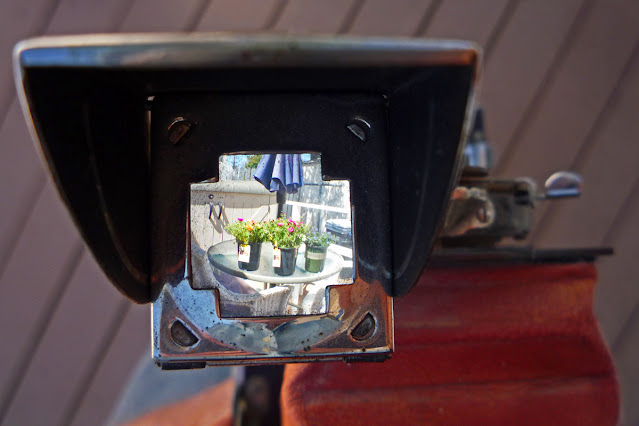There are several cameras in my collection that I like very much,
but none have taught me more about the art and craft of photography
than this modest little Kodak No.2 Folding Autographic Brownie. I
acquired two of them some years ago. Up until that time, I had very
little interest in the old Kodak folders that seemed rather awkward
looking and unpromising in terms of capacities. The first one I got was a
gift from a friend who had lost his home, most of his cameras and his
life's work in photography in a fire. The Brownie survived the fire in a
shed, but only barely; when I got it, the outer case was falling apart,
and the insides were covered with rust.
Oddly enough, the Brownie's lens, shutter and bellows seemed fine. I
cleaned up the thing as best I could and put a roll of 120 film through
it. I had little expectation of getting interesting photos from it, but
I thought my friend might like to see something come from one of the
few surviving cameras. To my surprise, the images were quite sharp and
had a great depth of tonality. A close examination of the outer rim of
the lens showed it to be a Rapid Rectilinear. That was a lens popular
early in the Twentieth Century with the f64 Group, and used by people
like Adams and Weston. While the uncoated lens does impart a particular
character to the tonal quality of images, I decided that the large 6x9
negatives were probably the main influence on the richness of the
tonality that came from the camera. I had seen something approaching
that from some of my previous box camera images, but the combination of
tonal range and sharpness from the Brownie was a real eye opener.

One thing that took me a while to understand was that the aperture
values on the shutter were not what they seemed. It is a rather odd
progression: "U.S. 4 8 16 32 64". It turns out that is the
Uniform System
used on some of the early Kodaks. The present-day standard for
aperture stops expresses them as a ratio of aperture to focal length; so
we get something like 8, 11, 16, 22, 32 with each increment indicating
half or twice the exposure. In the Uniform System, the "16" expresses
the same exposure value as the "16" in the current f-stop system, but
the numerals above and below are simply doubled or halved to indicate
the corresponding exposure change, rather than the proportional or ratio
expression of the current system. The relationship between the two
systems is perhaps most easily understood by looking at
a comparison table like the one available on the Kodak Classics site.
Another oddity of the exposure values on the shutter's face is the
wording attached to the numeric values, terms like "Clear", "Brilliant",
"Distant View", "Marine", "Clouds". This was Kodak's
Autotime Scale,
an exposure system intended to assist the amateur photographer in
choosing the proper time and aperture settings based on lighting
conditions and subject matter. The system depended on the fact that film
speed choices were very limited in those days, and it seems now to be
more quaint than practical. In any case, once you understand the
relationship of the Uniform System exposure values to present-day usage,
it is possible to ignore the wordy jumble and proceed as you might with
any camera.
Since the top shutter speed on the Brownie is 1/50th of a second, a
tripod is good insurance, though not absolutely necessary if you are
careful not to jiggle the camera during the exposure. Even when
hand-holding the camera, I have found it useful to use a cable release
in order to avoid the need to manipulate the release lever out on the
end of the long bellows. Given the large negative format, there is no
real penalty in terms of grain in using 400-speed film which permits
small f-stops and good depth of field, along with superior tonal
rendition.
My friend's Brownie wasn't really a very practical shooter because of
the damage it had sustained, but I decided I needed to do something to
to further explore its capabilities. I therefore purchased a nearly
identical camera on line for about five bucks that had a simple meniscus
lens. It was no great feat to transplant the Rapid Rectilinear and its
ballbearing shutter to the newly acquired camera body. It took me a
few rolls to sort out the best ways of using the Brownie, but in the end
I got photos from it which I think are among the very best I have made
over the years.
I have since acquired a fair number of Kodak and other folders with more
advanced capabilities and more complex lenses than that on the Brownie,
but I don't honestly think they have made better pictures for me.
Some sample images from the Kodak No.2 Folding Autographic Brownie:






























